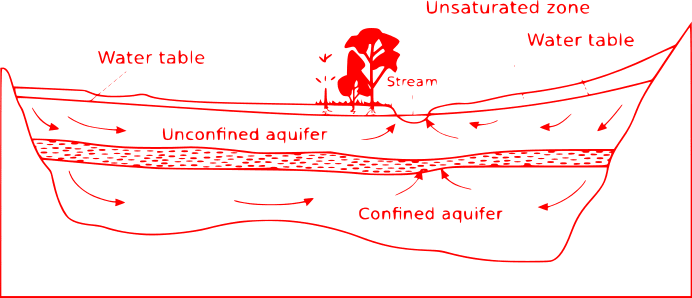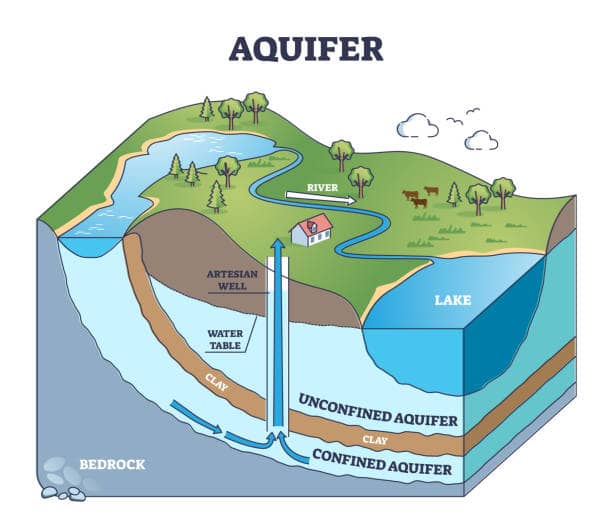What is Aquifuge?
Aquifuge is a geological formation that is not porous nor permeable. There is an absence of interconnected openings so it cannot transmit water. Any massive compact rock without any fractures is called an aquifuge. Solid rocks are a type of Aquifuge.

What is an Aquifer?
An Aquifer is a saturated formation of earth material that not only stores water but also yields it in sufficient quantity. It is a permeable stratum or a geological formation of permeable material. Aquifers are capable of yielding large quantities of available groundwater under gravity. The aquifer transmits water relatively easily due to its high permeability. Sand and gravel of unconsolidated deposits form good aquifers. The groundwater availability of a place from an aquifer depends upon the rates of recharge and withdrawal. Aquifer allows both the transmission conduit and storage for water. Aquifers are found in different depths, lateral extent, and thicknesses. But based on the occurrence and field situation aquifers are classified into unconfined aquifers and confined aquifers.
The groundwater availability of a place from an aquifer depends upon the rates of recharge and withdrawal. Aquifer allows both the transmission conduit and storage for water. Aquifers are found in different depths, lateral extent, and thicknesses. But based on the occurrence and field situation aquifers are classified into unconfined aquifers and confined aquifers.
Also Read: Reservoirs and Dams
Types of Aquifer

1. Unconfined Aquifer
- It is the topmost water-bearing stratum having no aquiclude lying over
- Unconfined aquifers are also known as water table aquifers or non-artesian aquifer
- This is a free water surface aquifer which means there exist a water table
- Through the infiltration of precipitation from the ground surface, the recharging of these aquifers takes place.
- If a well is driven into an unconfined aquifer it will indicate a static water level corresponding to the water table level at that location.
2. Confined Aquifer
- Confined aquifers are also known as an artesian aquifer
- The aquifers which are embedded between two impervious beds of Aquiclude or Aquifuge are called a confined aquifer
- These aquifers are recharged from the places which are opened or exposed to the ground surface
- The piezometric level will be much higher in this aquifer than the top level of the aquifer due to the water under pressure
- If both of the confining beds of a Confined aquifer are aquitards then it is also called a leaky aquifer.
What is Aquiclude?
Aquiclude is a geological formation that is impermeable which means it does not allow the passage of water through it. But it is highly porous so it contains a large amount of water in it. The aquiclude is formed when an aquifer is overlaid by a confined bed of impervious material. One example of aquiclude is clay.
What is Aquitard?
Aquitard is a formation that only allows only the seepage of water and the yield from aquitard is very high when compared to an aquifer. Since it has a large amount of water there is a possibility of water escaping from the aquitard to the aquifer below it. These do not allow the flow of water underground because of its compacted layers.
Aquitards acts as a barrier for groundwater flow and also disconnects partially the flow of groundwater by separating the aquifers. These limit and direct the surface water which seeps down to the aquifers because of that they are also called cap rocks. Aquitards only act as a barrier to the flow of water but allow the seepage of water through the aquitards.
Difference between aquifer, aquiclude, aquitard, and aquifuge
| Aquifer | Aquiclude | Aquitard | Aquifuge |
| These are permeable | These are impermeable | These are partly permeable | These are impermeable |
| There is a yield of water | These do not yield water | There is a yield of water but the yielding will be so slow | These do not yield water |
| This can store water | This can store water | This can store water | This cannot store water |
| Sand and gravel are some of the examples of aquifer | Clay is an example of an aquiclude | Sandy clay is an example of aquitard | Compact rocks like basalt and granite are some of the examples of Aquifuge |
Also Read: Rainwater Harvesting System


Leave a comment